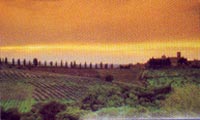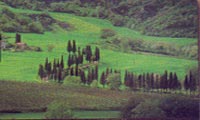|
|
||||||||||
Indulge in the Tuscan Lifestyle... Discover the Jewels of Tuscany in a Florence Villa |
||||||||||
| ||||||||||
|
Tourist Itineraires
Florence is one of the most famous cities in Italy. As the birthplace of the Renaissance it preserves some of the greatest works of art and most beautiful buildings in the world.
It is not only one of the most fascinating towns in Tuscany, but is also in a particulary beautiful position, with lovely environs. It has preserved its medieval character.
standing on the Arno a few miles from its mouth, it is famous for its beautiful Piazza del Duomo, with the Cathedral, Leaning Tower, and Baptistery
On the southwest slope of Monte Albano, 11 km north of Empoli, in beautiful countryside, is the little village of Vinci, famous as the birthplace of Leonardo da Vinci.
lies in a magnificent position on a precipitous hill with open views in every direction across a splendid yellow and grey landscape of rolling clay hills.
San Gimignano preseres its medieval appearance more completely than any other town in Tuscany. It is famous for its numerous towers, providing a remarkable sight in Italy.
Like many other Tuscan towns, Certaldo is divided between its medieval walled town on a hill and the modern esidential and industrial suburb spread out below.
Montelupo Fiorentino is an attractive village where the Pesa and Arno rivers meet. Known for the wine production, the artistic glass and the ceramic products
|
MontespertoliThe Commune of Montespertoli covers an area equivalenit to 125.02 sq.km., over some of the characteristic hills of Central Tuscany which form part of the Chianti area. The chief town sits 257 metres above sea level, 25km from Florence and is equidistant from the touristic centres of San Gimignano, Siena, Pisa and Volterra. The varied landscape consists of a morphologically uniform hill range with land which is fertile from a phycal and nutritional point of view. The land of the Val di Pesa hills, infact, being composed of marine sediment, is considered to be one of the best. On the whole the landscape can be described as Chianti-type because of its relatively modest altiude (maximum 442 metres above sea level at Lucardo) and by the presence of olive trees and vines. The climate, in spite of exposure to all winds, is mild. Continuous and free ventilation keeps the air pure and healthy. Montespertoli, with its vineyeards, cellars and the Chianti Show, is one of the Tuscan wine capitals. Historically the wine, as well as the oil and bread, has always been one of its most important features, and is weel-known in the region.The Commune is endowed with an efficient road network and with a series of refreshment places, featuring typical Tuscan cooking, a Tourist Information Office (headquarters of the Pro-Loco), an important tourist sports centre in Molino del Ponte with football pitch, five-a-side field, indoor tennis courts, trap shooting, sports stadium, swimming pool, hotel and restaurant. The layout of the area has permitted the organization of cultural itineraries which can occupy several days' stay. Of particulary interest is the Museo di Arte Sacra in the parish church of San Piero in Mercato and the A. Bassi Picture Gallery in Piazza Machiavelli.
The territory of the present Municipality of Montespertoli played an important role in past times, surely since the Etruscan period, because of its road network which enabled Florence to trade towards Volterra and Siena along the Via Volterrana. This road actually crossed the territory of Montespertoli from North to south and joined the Via Francigena at Certaldo. Scattered along the Via Volterrana can be found settlements of the nobility dating back to the early Middle Ages: to the North near Montegufoni there was the castle of the Ormanni which was destroyed by the Florentines in 1135. After the destruction of tha Ormanni castle, Gugliarello Acciaioli from Brescia bought a lot of land in the area and one hundred and fifty years later, on 12 September 1310, the Great Seneschal Niccolò Acciaioli was born there.
The Acciaioli bequeath the church of San Lorenzo in Montegufoni works of art of very fine quality: a Crucifix by Taddeo Gaddi. The Acciaioli family decayed early in the XVIIth century and all their estates were bought by the Usibardi family, extinct in 1663. Then a descendant of another branch of the Acciaioli line, Donato, succeeded in buying back all the family properties and starting a new period of wealth which lasted throughout the XVIII century. The castle standing to one side of Montespertoli, today the property of the Sonnino, originally belonged to the Signori of Montespertoli, a branch of the Dukes Alberti from Mangona but, since ttheir family became extinct in 1393, they bequeathed all their properties to the Machiavelli. The estates of this family stretched over almost two thirds of the present Municipality of Montespertoli and we owe them the very great number of art in most churches of the territory. Montespertoli, of medieval origin, had its first church inside the castle of the Signori of the town, and only at the beginning of the XVth century the Churh of Sant'Andrea, presently in Piazza Machiavelli, was built and later restored after the damages caused by the Second World War. In the territory of Montespertoli the Parish-church of San Piero in Mercato represents together with the village of Lucardo the most ancient centre dating back to the early Middle Ages.
Today the oldest traces left of the church date from the Romanesque period, but we can reasonably assume that a building of a very simple structure stood on the same spot before the year one thousand and was destroyed in the course of the building activity The small Sanctuary of St. Mary of Peace, in the Convent of Botinaccio, built in the XVI century, has been expanded from year to year to get the present dimension. It became Franciscan Friars' property until the French invasion in the decade of the last century. In the chapel, there are some frescoes dating back to around 1600.
|
 Florence (20 km.)
Florence (20 km.) Sie
Sie Pisa (50 km.)
Pisa (50 km.) Vinci (25 km.)
Vinci (25 km.) Volterra (45 km.)
Volterra (45 km.) San Gimignano (28 km.)
San Gimignano (28 km.).jpg) Certaldo (17 km.)
Certaldo (17 km.) Montelupo Fiorentino (15 km.)
Montelupo Fiorentino (15 km.)
